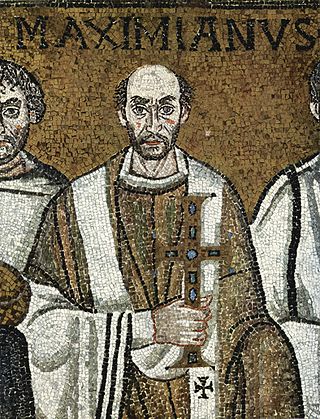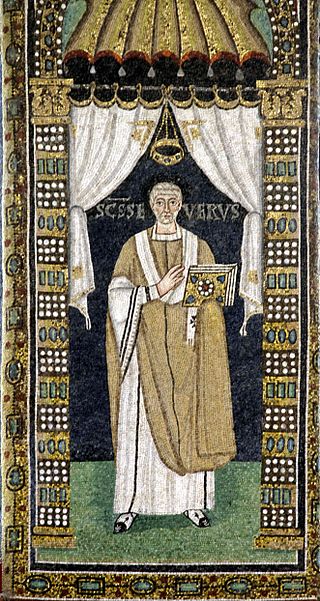Related Research Articles
Saint Metrophanes was the bishop of Byzantium from 306 to 314. He may have retired from his episcopacy and died as late as 326.

Peter Chrysologus was Bishop of Ravenna from about 433 until his death. He is known as the “Doctor of Homilies” for the concise but theologically rich reflections he delivered during his time as the Bishop of Ravenna.
Theodore II was Exarch of Ravenna from 677 to 687.

Apollinaris of Ravenna is a Syrian saint, whom the Roman Martyrology describes as "a bishop who, according to tradition, while spreading among the nations the unsearchable riches of Christ, led his flock as a good shepherd and honoured the Church of Classis near Ravenna by a glorious martyrdom."

The Basilica of Sant' Apollinare in Classe is a church in Classe, Ravenna, Italy, consecrated on 9 May 549 by the bishop Maximian and dedicated to Saint Apollinaris, the first bishop of Ravenna and Classe.

The Basilica of San Vitale is a late antique church in Ravenna, Italy. The sixth-century church is an important surviving example of early Christian Byzantine art and architecture, and its mosaics in particular are some of the most-studied works in Byzantine art.. It is one of eight structures in Ravenna inscribed on the UNESCO World Heritage List. Its foundational inscription describes the church as a basilica, though its centrally-planned design is not typical of the basilica form. Within the Roman Catholic Church it holds the honorific title of basilica for its historic and ecclesial importance.
Andreas Agnellus of Ravenna was a historian of the bishops in his city. The date of his death is not recorded, although his history mentions the death of archbishop George of Ravenna in 846; Oswald Holder-Egger cites a papyrus charter dated to either 854 or 869 that contains the name of a priest named Andreas of the Church of Ravenna, but there is no evidence to connect him with Andreas Agnellus.

January 11 - Eastern Orthodox liturgical calendar - January 13
This page is a list of Catholic bishops and archbishops of Ravenna and, from 1947 of the Archdiocese of Ravenna and Cervia, which in 1985 became styled the Archdiocese of Ravenna-Cervia. The earlier bishops were frequently tied to the Exarchate of Ravenna.

Maximianus of Ravenna, or Maximian was bishop of Ravenna in Italy. Ravenna was then the capital of the Byzantine Empire's territories in Italy, and Maximianus's role may have included secular political functions.

The Archdiocese of Ravenna-Cervia is a Latin Church metropolitan archdiocese of the Catholic Church in the Emilia-Romagna region of Italy.
Eleuchadius is a 2nd-century Christian saint venerated by the Roman Catholic and Eastern Orthodox Churches. He served as the third bishop of Ravenna from 100 to 112.
Adheritus was Bishop of Ravenna during the 2nd-century and successor to Saint Apollinaris, the first bishop of Ravenna. He was of Greek origin and was a follower of Apollinaris Adheritus died on 27 September at the port of Classe, and his remains are venerated in the Basilica of Sant'Apollinare in Classe near Ravenna, Italy

Ursicinus is a saint of the Catholic Church and was Bishop of Ravenna from 533 to 536. He is not to be confused with the 1st-century saint Ursicinus of Ravenna.
Agnellus was a bishop of Ravenna in the Praetorian prefecture of Italy from 557 to his death. The main source about him is by Liber Pontificalis Ecclesiae Ravennatis by Andreas Agnellus.

Ravenna Cathedral is a Roman Catholic cathedral dedicated to the Resurrection of Jesus Christ in the city of Ravenna, Italy. Formerly the archiepiscopal seat of the Archdiocese of Ravenna, it is now the seat of the archbishops of Ravenna-Cervia.

Saint Severus of Ravenna was a 4th-century Bishop of Ravenna who attended the Council of Sardica in 343. He was ordained as a bishop due to his personal virtue and because of "the sign of a dove". He is commemorated on February 1.
← November 9 | November 10 | November 11 →

Ursus was bishop of Ravenna during the late 4th century.

Ecclesius was bishop of Ravenna from AD 521 to 532. He is best known as the founder of the Basilica of San Vitale in Ravenna.
References
- ↑ "St. Dathus". Catholic Online.
- ↑ Agnellus of Ravenna; Deliyannis, Deborah Mauskopf (2004). The Book of Pontiffs of the Church of Ravenna (Medieval Texts in Translation). Washington, D.C.: Catholic University of America Press. p. 108. ISBN 978-0-8132-1358-3.